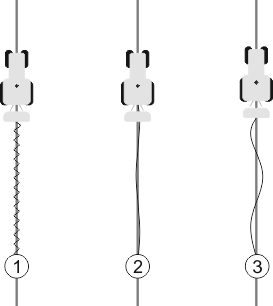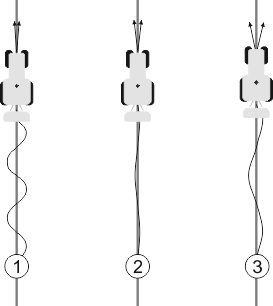Fine adjustment of the steering system
Because the steering system was already calibrated, it works smoothly in almost all situations. However, it may be necessary to adjust the values under special circumstances. For example, for special field conditions, implements, forward speed etc.
Ruling out causes
When the system is not steering satisfactorily:
- 1.
- Check the quality of the GPS signal.
- 2.
- Ensure that the steering job computer is installed at a vibration-free position with its intended bracket.
- 3.
- Ensure that the GPS receiver is installed at its intended position.
- 4.
- Ensure that you have selected the correct vehicle profile and machine profile.
Fine adjustment
When you have ruled out other causes, you can perform fine adjustment on the steering system.
After calibration, the optimum value for the selected vehicle without implement appears for each parameter. You can adjust the values for the current field conditions and for the mounted implement by increasing or reducing the parameters incrementally.
Change the following parameters individually and consecutively such that the steering system reacts optimally. Check the effects after each change:
- 1.
- “Motor aggressivity” - Only for systems with a steering wheel motor.
- 2.
- “Steering response”
- 3.
- “Heading Aggressiveness”
- 4.
- “Cross Track Error”
- 5.
- “Line Acquisition”
- 6.
- “Reverse response”
If the system works better afterwards, but still not optimally, repeat the settings in this sequence.
Procedure
To see the parameters:
- 2.
- Open the TRACK-Leader application.
- 3.
- Ensure that the proper Vehicle profile is activated for the vehicle.
- 4.
- Start a new navigation.
Parameter set
This parameter shows you the combinations of vehicle and mounted implement for which parameters have been configured and saved.
The parameter set gets the parameters from two sources:
- ▪
- From the vehicle profile in the TRACK-Leader AUTO menu.
- ▪
- From the mounted implement through the job computer or a virtual job computer from the Virtual ECU.
When you connect a known vehicle combination, the previously used steering parameters for this vehicle combination are always loaded.
Line Acquisition
With this parameter, you can determine how fast the system steers in the direction of a newly created guidance line.
The goal of this setting must be that the vehicle takes the shortest path without having to steer sharply or suddenly.
Steering response (when driving forwards)
With this parameter, you can determine how fast the system reacts to steering commands when driving forwards.
Reverse response
With the parameter, you can determine how fast the system reacts to steering commands when driving in reverse.
Corresponding parameter in the steering job computer: “Reverse response” (Reverse Response)
Heading Aggressiveness
With this parameter, you can determine how strongly the wheels should be steered back by the system to correct the route.
- ▪
- If the system corrects the wheel too early, the vehicle becomes unsteady. The entered value is too high.
- ▪
- If the system steers the wheels back too weakly and slowly, the vehicle often leaves the guidance line. The entered value is too low.
To check this, you can observe the movements of the tip of the vehicle:
The more often the tip of the vehicle changes direction, the more often the vehicle meanders
Corresponding parameter in the steering job computer: “Heading Aggressiveness” (Heading Aggressiveness)
Cross Track Error
With this parameter, you can determine the deviation from the ideal guidance line at which the system starts to correct the driving direction. In other words, you can set the number of centimetres with which the vehicle is allowed to drive beside the guidance line.
The more often the system detects an error, the more often it corrects the route
Corresponding parameter in the steering job computer: “Cross Track Error”
Motor aggressivity
With the parameter, you can determine how fast the steering wheel motor reacts to steering commands. The parameter works like “Steering response”, however, it only works with systems with a steering wheel motor.
Manual steering override
With this parameter, you can set the effort required to take over control of the steering wheel.
With the initial operation of the system, an initial value will be determined for the vehicle. This value must then be imported one time from the steering job computer, to enable fine-tuning at a later time.
When the set value is low, it is sufficient to hold the steering wheel to deactivate the steering system. When the set value is higher, more effort is required. When the set value is too low, it is possible that the system is deactivated when the effort required to move the wheels increases.
Examples:
- ▪
- With low-pressure tyres, on heavy soils or with an implement mounted on the front hydraulic system, the value may have to be increased for the system to be able to steer properly.
- ▪
- With narrow tyres and good conditions, the value must be reduced to ensure safety.


 .
.





